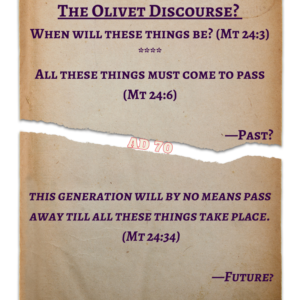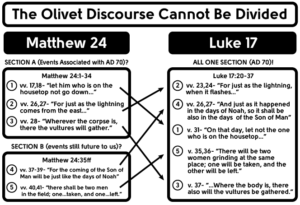I published Elder Michael Ivey’s essay on the Olivet Discourse in two previous posts (here and here). It contradicts my prophetic framework (i.e., inmillennialism1) and, therefore, my view of Paul’s “rapture passage” (1 Thess 4:13–5:11). I am responding to that essay: last week’s post contained Part 1; here, I will give Part 2.
![]()

The popular prophetic models deny Jesus’ timing in the Olivet Discourse (Matt 24–25; Mark 13; Luke 21:5–38). He said, “Assuredly … this generation will by no means pass away till all these things take place” (Matt 24:34). This timestamp resembles his earlier statement:
The Son of Man will come in the glory of His Father with His angels, and then He will reward each according to his works. Assuredly, I say to you, there are some standing here who shall not taste death till they see the Son of Man coming in His kingdom. (Matt 16:27–28)
Yet, the prophetic models insist that some of these events—the coming and parousia of Christ, the abomination of desolation, the “great tribulation,” etc.—did not occur in Jesus’ generation.
So, commentators who accept one of these models must place some of “these things” in our future. Some do so by taking generation to mean the Jewish race, not contemporaries. Others ignore the pronoun Jesus used, treating this generation as if it means that generation, one living in our future. Other commentators appeal to double fulfillment: things happened as Jesus said they would happen in his generation, but they will also happen a second time in our future. The fictitious “elastic time” idea appeals to others: a day is as a thousand years, so we cannot know what the timestamps in Scripture mean.
Elder Ivey does not appeal to any of these devices to support his future-oriented interpretation. Instead, he divides the Olivet Discourse to create a form of the common already-not-yet approach. This method says, “fulfillment is temporally transformed into a long, drawn-out, already—not yet period.”2 Elder Ivey says Jesus “addresses the beginning of fulfillment of the prophecy [in the Olivet Discourse], not its completion.”3
In my last post (here), I considered his appeal to the Greek word ginomai as the basis of his premise. Next week I will (D. V.) deal with his use of the Western Wall to illustrate that division. In my concluding post, I plan to show how dividing the Olivet Discourse spoils the parables of exhortation Jesus gave.
Here, I will make a single point: Elder Ivey’s division of the Olivet Discourse is a mistake.
The Crucial Argument—Part B
Elder Ivey divides the Olivet Discourse. He says Matthew 24:15–22 “contain(s) the prophecy of the destruction of the Temple” and Matthew 24:23–28 “denote(s) the sign and sureness of Christ’s second coming” in our future. He doesn’t explain how the disciples could have recognized that Jesus had changed topics. After our verse 22, how did they know the Lord began to speak of distant events unassociated with the temple’s fall? Without some indicator in the text, Elder Ivey’s division seems arbitrary.
I will give two reasons this division is a mistake. First, it clashes with the order of events Jesus gave in Luke 17:20–37. There, Jesus spoke of the same circumstances he described in the Olivet Discourse: the coming kingdom of God (Luke 17:20–21); the coming of the Son of Man as lightning (Luke 17:24); those days being like the days of Noah (Luke 17: 26–27); etc. The following chart shows how Elder Ivey’s division creates conflict:

Ed Stevens uses this chart4 to argue against dividing the Olivet Discourse at the end of Matthew 24:34. His logic also negates the proposed split at Matthew 24:22.
Elder Ivey says Jesus’ warning to those “on the housetop” (Matt 24:17–18)—item 1 in the chart—pertains to the temple’s destruction. But he says the Son of Man coming as in the days of Noah (Matt 24:37–39)—item 4 in the chart—pertains to our future. These two events fall on opposite sides of his dividing line in the Olivet Discourse. Item 1 is in our past; item 4 is in our future.
But Jesus reversed the order of these events in Luke 17. There, item 4 precedes item 1: the coming as in the days of Noah (Luke 17:26–27) comes first, then the warning to those on the housetop (Luke 17:31). If Elder Ivey’s dividing line in the Olivet Discourse existed, Jesus could not have rearranged the order of these two events. Luke 17 says all these events pertain to “the days of the Son of Man” (Luke 17:22, 24, 26, 30, 31). But, Elder Ivey says the warning pertains to the temple’s fall in AD 70 and the coming of the Son of Man to the end of history.
Second, Elder Ivey’s division is wrong because it disrupts the connection between these events. The Lord said, “Then there will be great tribulation” (Matt 24:21). Elder Ivey says this tribulation relates to the temple’s fall because it occurs before his proposed split. But Jesus said, “Immediately after the tribulation of those days the sun will be darkened…” (Matt 24:29). Elder Ivey says this sun-darkening will occur in our future. If this is true, something Jesus said would happen immediately after an event in his generation has not happened for almost two thousand years. This failed timing would make Jesus a false prophet.
Elder Ivey’s division creates problems regarding the order and connection of events in the Olivet Discourse. These difficulties disappear when we recognize Jesus’ unified thought: “all these things” pertained to the temple’s fall. They happened in Jesus’ generation. Jesus could vary the order of events because all of them would occur before some disciples died. He could place cosmic collapse imagery immediately after the tribulation because it represented Israel’s world that disintegrated when the temple fell.
Conclusion
The Olivet Discourse is a unit. Jesus foretold the temple’s fall (Matt 24:1–2), causing the disciples to ask about “these things” (Matt 24:3). The Lord answered their questions about “all these things” (Matt 24:6, 33). He said “all these things” would happen in his generation (Matt 24:34). In the Olivet Discourse, Jesus addressed a single topic—the temple’s destruction (Matt 24:1–2).5
We should never separate what God has joined.
Footnotes
- I document this perspective in Michael A. Rogers, Inmillennialism: Redefining the Last Days (Tullahoma, TN: McGahan Publishing House, 2020). This book is available here in hardcopy and here as a PDF. A free summary PDF document of inmillennialism is here.
- G. K. Beale, A New Testament Biblical Theology: The Unfolding of the Old Testament in the New (Grand Rapids, MI: Baker Academic, 2011), 939.
- My italics.
- Edward E. Stevens, What Happened in A.D. 70? (Bradford, PA: Kingdom Publications, 1997), 18–19. Used with permission. See also Rogers, Inmillennialism, 198. I reject Stevens’ full preterism.
- For a discussion of the final judgment in Matthew 25:31–46, see Rogers, Inmillennialism, 216–32.
